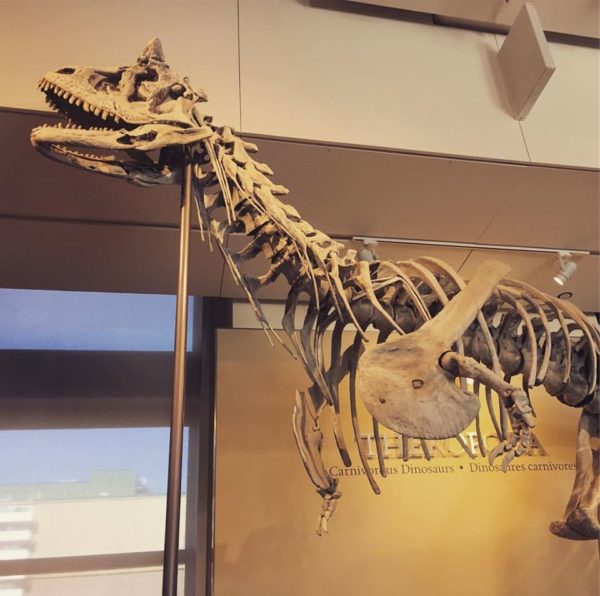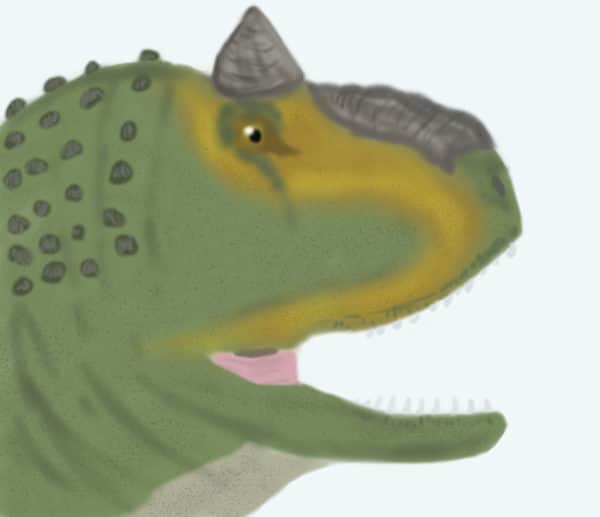
Imagine the world roughly 70 million years ago, during the late Cretaceous period. Global temperatures overall are quite warm, and the continents have yet to take the configuration we know them in today. Unbeknownst to them, the non-avian dinosaurs only have about four million years left. An endless expanse of time to us humans, but a drop in the greater cosmic bucket.
During this little slice of time, if you were walking around Alberta, Canada, between the Rocky Mountains and the Western Interior Seaway, you’d spot all sorts of dinosaurs that now fill the halls of North American museums. Vast herds of the flat-horned Pachyrhinosaurus or shovel-beaked Edmontosaurus, the feathered carnivore Atrociraptor, crested hadrosaurs like Hypacrosaurus or Saurolophus, the birdlike Epichirostenotes and Dromiceiomimus, and the horned giant Eotriceratops. The large carnivore niche was solely dominated by the lean yet powerful tyrannosaur Albertosaurus. Classic stuff to us Albertans with an interest in palaeontology. But if you zipped down to southern Argentina during this time, you’d experience a whole different type of fauna that, to my eyes at least, would have looked exotic, bizarre, and wonderful. The big carnivore at this place and time wasn’t some tyrannosaur, but the ‘meat-eating bull’ of South America, Carnotaurus.
Found in the late Cretaceous La Colonia Formation, Carnotaurus belongs to a group of theropod dinosaurs that often escape mainstream notice in American and European media, a family called the Abelisauridae. These carnivores are known from South America, Africa, and India, which at the time were all joined together with Antarctica and Australia into a supercontinent called Gondwana, itself being part of the remains of the original supercontinent, Pangea. Gondwana was, for the most part, separated from the North America-Europe-Asia landmass called Laurasia, and so the animals there were often quite distinct from the northern hemisphere species. Near the end of the Cretaceous, South America slowly began to pull away towards North America as Gonwana fractured, and the dinosaurs there became even weirder.
The abelisaurs were unknown to science until their discovery in South America in the mid 1980’s, when the family name was coined in the description of the first known species, Abelisaurus comahuensis (Bonaparte & Novas, 1985). These dinosaurs had arisen in the mid Jurassic from the horned ceratosaurs (Diego & Oliver, 2012), and were the apex predators in a world that had been previously dominated by the gigantic carcharodontosaurine theropods like Giganotosaurus, Mapusaurus, and Tyrannotitan through much of the Cretaceous. When this group of giant carnosaurs eventually went extinct in South America, and with the northern tyrannosaurs never making it that far south, the abelisaurs took over in their own fashion.
In general abelisaurs were built fairly ‘typically’ for theropods, with long, low bodies held parallel to the ground. However, their heads were radically short and deep, often with a somewhat upturned upper jaw and a shallow, slim lower jaw. This made these dinosaurs look sort of pug-faced by comparison to most other theropods. Their teeth were generally short and stout, and their arms were small. Really small. That long-tired joke about tyrannosaurs having short, useless arms doesn’t take into consideration the front limbs of abelisaurs. While the arms of tyrannosaurs were certainly reduced and not used for much, they at least could have performed some sort of function. Not in the abelisaurs, which had arms that were truly vestigial. The humerus, or upper arm bone, was generally the longest part of the arm, with the rest of the limb being so shrunken it’s barely there at all. Abelisaurs had individual finger bones, but these may not have ended in claws, or might not have even been separated on the outside at all. Some have even suggested that, like some flightless birds today, the front limbs of abelisaurs were so small that they may not have even been visible outside the body wall in life. These were truly useless arms.
On to Carnotaurus itself. This beast was described in the early days of abelisaur research by Jose Bonaparte (Bonaparte, 1985), the recently-passed godfather of Argentinian palaeontology who paved the way for this science in South America. The holotype specimen of this dinosaur is a remarkably complete one, with only the lower legs and most of the tail missing. In a family full of weird dinosaurs, Carnotaurus was extra weird, as many of the characteristic abelisaur adaptations are taken to the extreme in this species. The head of Carnotaurus was more squat and blunt than any of its known relatives. Its neck vertebrae were robust with upward-projecting processes that would have anchored thick, powerful muscles. The tail vertebrae bore sideways-pointing projections called transverse processes, something present in all other tailed vertebrates. However, in Carnotaurus these bony projections not only grew outwards but sharply upwards in a sickle-shaped design that curved forwards towards the animal’s front. Why it had these might seem baffling, but we’ll get to that later.

The skeleton of Carnotaurus on display at the Canadian Museum of Nature in Ottawa. Photo by Nicholas Carter
Perhaps the weirdest and most noticeable feature of Carnotaurus is the pair of horns growing over the dinosaur’s eyes. While other theropods such as Allosaurus, Ceratosaurus, and various tyrannosaurs had cranial horns as well, these were generally small, pointed upwards, and were formed out of the lacrimal bones just in front of the eyes. In Carnotaurus, however, the horns were formed by the frontal bones in the middle of the head and pointed outwards as well as up. They were also noticeably larger than the horns of any other theropod compared to the size of the skull. The gnarly, rugose texture of the horns indicates that they would have been covered with a sheath of keratin in life, which likely made the external horn much longer than the bony core suggests. These horns were the source of the dinosaur’s name, in fact, which means ‘meat-eating bull’.
So what was a carnivorous dinosaur like this using its horns for, anyway? While it has been suggested in the past that they might have been used to help bring down prey (Mazzetta et al., 1998), this idea is treated with more than a little skepticism, since no other animal living or extinct is known to hunt using cranial horns. A more readily accepted theory is that the horns were for combat between two individual Carnotaurus, perhaps for breeding rights or territory disputes. In what exact manner Carnotaurus used in horns for, though, has been debated by palaeontologists over time. Early ideas posited that they were used in a similar manner to modern bovids like sheep and cows, and that Carnotaurus violently rammed one another with their pointed horns (Paul, 1988) (Mazzetta et al., 1998) (Novas, 2009). Scientists advocating for this theory have pointed out that Carnotaurus had extremely strong neck muscles that may have been useful in delivering fast, powerful blows. Other authors have suggested that, instead of fast violent ramming, Carnotaurus may have slowly yet forcefully pushed or shoved each other with their heads, using their horns to help distribute the force of these shoves (Chure, 1998) (Mazzetta et al., 2009). Hey, maybe it did both.
Whatever its method, Carnotaurus does seem well-suited for head-to-head combat. Perhaps the bluntness and depth of the head helped with this sort of thing. It’s also worth noting that the bone along the top of the dinosaur’s snout is of a similar texture to the horn cores, indicating that it was covered with keratin as well, perhaps forming some kind of horned pad or boss. Maybe this could have been of further aid to the animal for combat purposes.

The head of Carnotaurus. As someone more accustomed to drawing long-snouted dromaeosaurs or tyrannosaurs, this creature just felt unnatural. By Nicholas Carter
Carnotaurus was more than just horns, though. The jaws of this dinosaur weren’t just short- the lower jaw was also quite shallow, unlike the bulky mandibles of many other theropods. This, combined with the relatively long hind limbs of Carnotaurus, has led some researchers to suggest that this species had a fairly weak, fast bite and therefore specialized in smaller, faster prey animals (Mazetta et al., 1998) (Mazzetta et al., 2009).
And Carnotaurus itself likely was quite fast. University of Alberta palaeontologists studied the strange shape of Carnotaurus tail vertebrae and realized that the upward-facing transverse processes would have made lots of room for the caudofemoralis muscle (Persons & Currie, 2011). This muscle ran along the lower sides of the tail of dinosaurs and pulled the femur backwards when contracted, providing most of the walking power. With all this room at the bottom of the tail, the cadofemoralis of Carnotaurus was greatly enlarged. This made the tail extremely round and thick, especially near the base, and provided a substantial amount of power for moving the legs (keep this in mind when drawing dinosaurs- many types, not just Carnotaurus, had very thick tails, especially near the base). This would have resulted in Carnotaurus being very fast, but not terribly agile. With more room at the underside of the tail for the leg retractor muscles, this meant less space for the muscles on top of the tail which provided it with stability and movement. Carnotaurus sort of got around this with its interlocking tail vertebrae parts which stiffened the tail but, as Persons and Currie argued, it wouldn’t have been able to make tight turns easily with such a rigid tail. If you can, try running as fast as you can while carrying a long, still board behind you, and then try and turn as sharply as possible. You’ll see what I mean.
Does this imply that Carnotaurus wasn’t as suited to chasing smaller, nimble prey as we thought? Perhaps. Some palaeontologists have argued that the bite strength of this dinosaur was not as weak as others have suggested, and that it was well adapted at delivering strong, slashing bites to large prey (Therrien et al., 2005). Maybe its hunting strategy was a fast, head-long dash at large herbivores followed by a nasty, slicing bite to cripple they prey. We don’t know for sure, but like many living animals, I suspect that while Carnotaurus may have had its preferred food sources, in life it ate whatever the heck it wanted to (or, rather, whatever it could catch and kill).
What further brings Carnotaurus to life for us is the presence of extensive skin impressions found with this animal. While fairly common in large herbivorous dinosaurs, skin impressions in theropods are rarer, but the holotype of Carnotaurus came with quite a bit from various parts of the body. The skin of the dinosaur was scaly, a rare bit of positive evidence of a non-feathered theropod (Czerkas & Czerkas, 1997). Most of the scales of Carnotaurus were small, as is typical for dinosaurs, but there was also irregular rows of larger, bump-like scales running down the back and tail, possibly used for protection during combat. What colour Carnotaurus was is still up in the air, and we may never know for sure.
What is nice to see is that, despite not being a ‘mainstream’ dinosaur yet, Carnotaurus has been featured in some popular media. Notable examples include in the Disney movie Dinosaur (where it anachronistically does battle with the film’s Iguanodon star if I recall correctly) and, more recently, in Jurassic World: Fallen Kingdom where it unfortunately gets taken down by the Tyrannosaurus. Still, it’s good to see a dinosaur from an underrepresented place and family have the spotlight thrown on it. Who knows what other amazing and strange dinosaurs the continent of South America holds for us to discover?
By Nicholas Carter
References
Bonaparte, José F. (1985). “A horned Cretaceous carnosaur from Patagonia”. National Geographic Research. 1 (1): 149–151.
Bonaparte, J.F. & Novas, F.E. (1985). [“Abelisaurus comahuensis, n.g., n.sp., Carnosauria of the Late Cretaceous of Patagonia”.] Ameghiniana. 21: 259–265.
Bonaparte, José F.; Novas, Fernando E.; Coria, Rodolfo A. (1990). “Carnotaurus sastrei Bonaparte, the horned, lightly built carnosaur from the Middle Cretaceous of Patagonia” (PDF). Contributions in Science. 416: 1–41.
Chure, Daniel J. (1998). “On the orbit of theropod dinosaurs”. Gaia. 15: 233–240.
Czerkas, Stephen A.; Czerkas, Sylvia J. (1997). “The Integument and Life Restoration of Carnotaurus”. In Wolberg, D. I.; Stump, E.; Rosenberg, G. D. (eds.). Dinofest International. Academy of Natural Sciences, Philadelphia. pp. 155–158.
Diego Pol & Oliver W. M. Rauhut (2012). “A Middle Jurassic abelisaurid from Patagonia and the early diversification of theropod dinosaurs”. Proceedings of the Royal Society B: Biological Sciences. 279 (1804): 3170–5.
Mazzetta, Gerardo V.; Fariña, Richard A.; Vizcaíno, Sergio F. (1998). “On the palaeobiology of the South American horned theropod Carnotaurus sastrei Bonaparte” Gaia. 15: 185–192.
Mazzetta, Gerardo V.; Cisilino, Adrián P.; Blanco, R. Ernesto; Calvo, Néstor (2009). “Cranial mechanics and functional interpretation of the horned carnivorous dinosaur Carnotaurus sastrei”. Journal of Vertebrate Paleontology. 29 (3): 822–830.
Novas, Fernando E. (2009). The age of dinosaurs in South America. Bloomington: Indiana University Press.
Paul, Gregory S. (1988). Predatory Dinosaurs of the World. pp. 284–285
Persons, W.S.; Currie, P.J. (2011). Farke, Andrew Allen (ed.). “Dinosaur Speed Demon: The caudal musculature of Carnotaurus sastrei and implications for the evolution of South American abelisaurids”. PLoS ONE. 6 (10): e25763. Bibcode:2011PLoSO…625763P. doi:10.1371/journal.pone.0025763
Therrien, François; Henderson, Donald; Ruff, Christopher (2005). “Bite Me – Biomechanical Models of Theropod Mandibles and Implications for Feeding Behavior”. In Carpenter, Kenneth (ed.). The carnivorous dinosaurs. Indiana University Press. pp. 179–198, 228.

